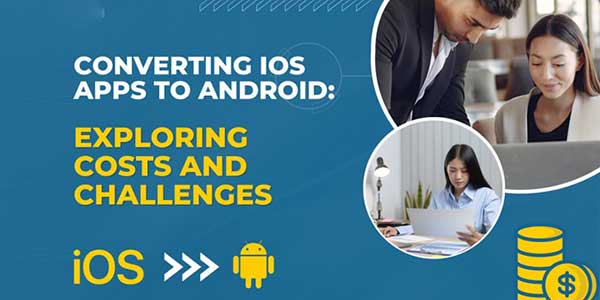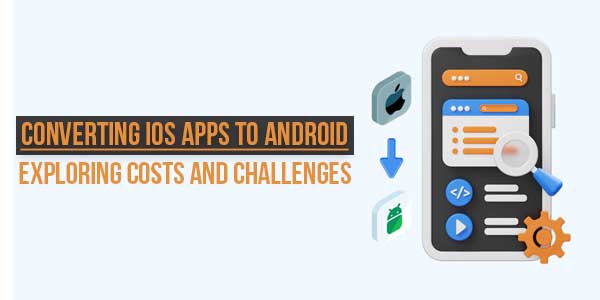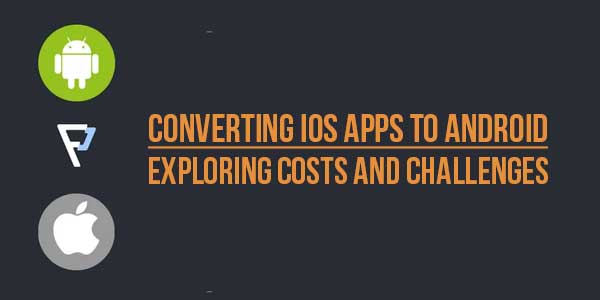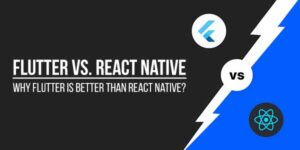
So, you have this amazing iOS app that you think would be a hit on the Android platform as well, huh? Well, converting iOS apps to Android is not as simple as clapping your hands and saying “Abracadabra!” Nope, you’ll need to put in some time, and effort, and maybe even sacrifice a few sleepless nights. But hey, no pain, no gain, right?
In this blog, we’ll explore the costs and challenges associated with converting iOS apps to Android. Brace yourself for a rollercoaster ride through the world of fragmentation, design guidelines, app store limitations, and so much more! We’ll also dive into cost considerations, determining the scope of the conversion, hiring the right development team, and best practices for a successful conversion. So, let’s grab our metaphorical magnifying glass and get ready to decode the secrets of iOS-to-Android app conversion!
Table of Contents
The Differences Between Ios And Android Platforms:
The Differences Between iOS and Android Platforms Ah, the great iOS versus Android debate. It’s like deciding between a sleek, expensive sports car and a reliable, slightly less glamorous sedan. Both have their pros and cons, and the same applies to the platforms they run on.
iOS, Apple’s brainchild, is renowned for its closed ecosystem. It’s like that one overprotective parent who wants to make sure their child only interacts with a selected group of friends. This control has its advantages, though, as it results in a consistent user experience across all devices. Developers can code with peace of mind, knowing that their app will work flawlessly on any compatible iOS device.
On the other hand, Android is like a wild zoo where different species of animals roam freely. With its open-source platform, it offers more freedom and flexibility. However, this freedom comes at a cost: fragmentation. Android devices come in various sizes, shapes, and hardware capabilities, making it a nightmare for developers trying to ensure their app works across the entire Android ecosystem.
Moreover, iOS and Android have different design guidelines. iOS loves its iconic, minimalistic approach to user interface design, while Android takes a more customizable and versatile route. This means developers need to adapt their app’s design to match the unique look and feel of each platform. It’s like trying to fit a square peg into a round hole—challenging, but not impossible.
Another challenge with Android is managing performance and battery life. Android devices tend to have varying hardware specifications, so optimizing your app to run smoothly across all devices can be a Herculean task. Balancing performance without draining the battery life is yet another tightrope act for developers.
Lastly, navigating the app stores is another adventure in itself. While Apple’s App Store is known for its strict guidelines, Android’s Google Play Store has a more relaxed approach. This means developers need to be aware of and adhere to the rules and limitations set by each store.
When it comes to converting iOS apps to Android, these differences and challenges need to be taken into account. It’s like learning a new language and adapting to a different culture—exciting yet demanding. But fear not, for with careful planning and the right expertise, success can be within reach. So, buckle up and get ready to conquer the world of Android!
Challenges In Converting Ios Apps To Android:
Challenges in Converting iOS Apps to Android Oh, so you want to convert your shiny iOS app to Android? Well, buckle up because it’s not going to be a smooth ride! Converting iOS apps to Android comes with its fair share of challenges and headaches. Let’s dive into the key obstacles you’ll face in this bumpy journey.
First off, let’s talk about the elephant in the room: fragmentation of Android devices. Unlike iOS, where you have a limited number of devices to cater to, Android is like a wild zoo with a multitude of smartphones and tablets. Each device has its own unique screen size, resolution, and hardware specifications. Talk about a party where no two guests are alike! So, be prepared to deal with device compatibility issues and spend countless hours tweaking and optimizing your app for different Android devices.
And while we’re on the topic of differences, let’s not forget about adapting to different design guidelines. Android has its own Material Design guidelines, and if you want your app to blend seamlessly into the Android ecosystem, you’ll have to kiss your iOS design principles goodbye. It’s like learning a completely new dance routine – frustrating and time-consuming. So, channel your inner Picasso and get ready to revamp your app’s user interface to match Android’s aesthetic preferences.
Next, let’s shine a light on the challenge of managing performance and battery life. Android devices vary in terms of processing power, memory, and battery life. You might have designed your iOS app to be lightning-fast and battery-friendly, but when you jump into the Android realm, all bets are off. Brace yourself for optimizing code, tweaking algorithms, and testing performance on various Android devices to ensure a smooth and power-efficient user experience.
Ah, and we can’t forget about those pesky app store limitations. Apple’s App Store is known for its strict review process, but Android’s Play Store has its own set of restrictions. From content guidelines to monetization policies, you’ll have to navigate various hoops and hurdles to get your app approved and featured on the Play Store. So, get ready for some paperwork and finger-crossing moments as you wade through the sea of app store limitations.
Converting iOS apps to Android is no walk in the park. You’ll find yourself juggling device compatibility, redesigning the user interface, optimizing performance, and tackling app store restrictions. It’s like being a one-person band playing multiple instruments simultaneously. But fear not, intrepid developer! With some perseverance and a healthy dose of patience, you can conquer these challenges and bring your iOS app to the Android world. So, put on your superhero cape and get ready to make your mark in the Android universe!
Cost Considerations:
Converting iOS apps to Android may seem like a daunting task, but it’s important to consider the cost implications before diving in.
One key consideration is the necessary resources for the conversion. You’ll need experienced developers who understand both iOS and Android platforms, as well as the differences between them. Hiring in-house developers can be costly, especially if they need to be trained in Android development. Outsourcing to a specialized development team might be a more cost-effective option.
You also need to assess the complexity of your app. Apps with simple functionality and fewer features will naturally cost less to convert. On the other hand, if your iOS app has complex features and intricate code, be prepared for higher costs and possible delays in the conversion process.
Testing and debugging are crucial aspects to consider in terms of cost. Android devices come in various sizes and specifications, leading to device fragmentation. Ensuring that your app works seamlessly across different devices can be time-consuming and costly.
Lastly, be aware of the limitations of the Android app store. There might be restrictions on certain features or design elements that work perfectly fine on iOS. Adapting your app to meet these requirements can add to the overall cost.
Converting iOS apps to Android is not a decision to be taken lightly. By considering these cost factors upfront and planning accordingly, you can save yourself from unexpected surprises along the way. Remember, though, that Rome wasn’t built in a day, and neither will your Android app. So, brace yourself and buckle up for a roller coaster ride of cost considerations. Time to convert and conquer!
Determining The Scope Of The Conversion:
Converting an iOS app to Android may sound as easy as changing a lightbulb, but trust me, it’s more like rewiring an entire electrical system. So, before you venture down this treacherous path, let’s dive into the key factors that will determine the scope of your ambitious conversion.
First things first, you need to evaluate the complexity of your app. Is it a simple flashlight app or a highly sophisticated social media platform? The complexity will determine the amount of work required to convert it to Android. So, let’s hope your app isn’t a complex labyrinth of code!
Next, you need to identify the features and functions that must be present in the Android version. Just because your iOS app has a certain feature, doesn’t mean it can easily be replicated on Android. Prepare yourself for those heartbreaking moments when you realize you have to say goodbye to some beloved features. RIP.
Now comes the fun part: testing and debugging. Brace yourself for the never-ending cycle of fixing bugs and making improvements. Android’s diverse ecosystem means your app will be unleashed on a multitude of devices with varying specifications. It’s a bit like releasing a pack of wild animals into a zoo and hoping they all behave properly. Good luck with that!
Remember, we’re not done yet. The conversion process requires some serious coding skills and expertise. While you can attempt it in-house, it’s always a good idea to consider outsourcing to experienced developers who know their way around Android. After all, you don’t want your app to end up looking like an alien in a foreign land.
So, there you have it. The daunting task of converting an iOS app to Android boils down to evaluating complexity, identifying required features, and testing and debugging. Oh, and let’s not forget the joy of finding the right development team.
Just remember to have a sense of humor and a hearty dose of patience. After all, converting an app from one platform to another is like navigating a minefield filled with unicorns and dragons. But hey, if you can conquer this challenge, you’ll emerge as a true app development hero!
So, gear up, grab your coding tools, and get ready to embark on the crazy adventure of converting your iOS app to Android. May the code be with you!

Hiring A Development Team:
Hire an Android developer: So, you’ve decided to convert your iOS app to Android. Great! But before we can dive into the nitty-gritty of the conversion process, let’s talk about one crucial aspect – hiring a development team.
Now, you have two options here: in-house development or outsourcing. In-house development might sound appealing because you have complete control over the process. You can walk down the hallway and directly ping your developers whenever you have a brilliant idea or a last-minute change. Plus, you get to witness the heated arguments about code implementation firsthand. Ah, the thrill!
But wait, before you start imagining yourself as the next Silicon Valley genius, let’s consider the downsides. In-house development can be quite expensive. You need to hire and maintain a team, which means hefty salaries, office space, and endless cups of coffee. And let’s not forget the overhead costs! It can quickly add up, draining your budget faster than you can say “debugging.”
Now, let’s talk about the alternative – outsourcing. You can hand over the reins to a team of experts who specialize in Android app development. They know the ins and outs of the platform, and best of all, they won’t ask you for a raise or take vacations (well, some may survive on coffee alone, but that’s beside the point).
Outsourcing can offer you cost savings and flexibility. You can hire a team based on the project’s needs, without worrying about long-term commitments. Plus, you’ll have their undivided attention since they won’t be distracted by internal office dramas or run out of snacks in the kitchen.
But, beware! Finding the right expertise is crucial. You don’t want to end up with a team that specializes in turning potatoes into chips rather than converting iOS apps to Android. Look for developers with a proven track record, read reviews, and check their portfolios. It’s like online dating but for your app!
So, before making the big decision, weigh the pros and cons. Do you want the thrill of in-house development or the sheer pleasure of outsourcing? The choice is yours! Just remember, developers are like unicorns – finding the right one can be a magical experience. Well, now that we’ve explored the joys and sorrows of hiring a development team, it’s time to move on to estimating time and resources. But don’t worry, we’ll get to that in a jiffy. Stay tuned!
Estimating Time And Resources:
Estimating Time and Resources Now that you have a clear understanding of the challenges involved in converting iOS apps to Android, let’s talk about estimating the time and resources required for this complex task. Brace yourself, because this is where things get even more intriguing!
The time and resources needed for a successful conversion greatly depend on several factors, such as the complexity of your app, the number of required features, and the amount of testing and debugging required. It’s like trying to predict the outcome of a magic trick – you can’t be entirely sure!
But fear not, my friend! With proper planning and the right team, you can stay a step ahead of these variables. Take into account code refactoring, optimizing the user interface, and thorough testing and quality assurance. These steps will ensure a smoother conversion process. You’ll feel like a skilled tightrope walker, gracefully navigating the challenges of iOS-to-Android app conversion.
The most crucial thing to remember is that rushing this process could lead to disastrous results. It’s like trying to fit an elephant into a matchbox – it’s just not going to work! So, take the time to evaluate each element and allocate resources accordingly. It’s all about making informed choices and letting the process unfold its magic!
And voila! There you have it, a comprehensive overview of estimating time and resources for converting iOS apps to Android. It may have felt like trying to solve a Rubik’s Cube blindfolded, but with the right mindset and knowledge, you can conquer this challenge and emerge victorious! So, tighten your belt and get ready for an exciting ride ahead!
Best Practices For Successful Conversion:
So, you’ve decided to convert your iOS app to Android. Great choice! But hold on, before you dive headfirst into this adventure, let me share with you some tried and tested best practices. Trust me, they’ll save you from some major headaches and frustrations along the way.
First things first, let’s talk about code refactoring. Converting your app to a different platform is like giving it a makeover. You need to clean up your code and make it more efficient and optimized for Android. It’s like decluttering your wardrobe, getting rid of those old, unused clothes. And no, you can’t just shove them into a drawer and hope no one notices. Android users are a discerning bunch, so make sure your code is sleek, neat, and tailored specifically for their devices.
Next up, optimize the user interface. Android users have grown accustomed to a certain look and feel. It’s like they’ve developed a taste for a particular brand of coffee and won’t settle for anything less. So, give them what they want. Pay attention to the design guidelines provided by Google, and make sure your app looks and behaves like a true Android native. Trust me, your users will appreciate it.
Now, let’s talk about testing and quality assurance. This is where you get to put your app through its paces, just like a marathon runner preparing for a race. Test it on different devices, screen sizes, and resolutions. Android comes in all shapes and sizes, so make sure your app can handle the diversity. And don’t forget about those pesky bugs. Squash them like you would a mosquito on a summer night. Your users will thank you for it.
In a nutshell, converting your iOS app to Android requires some serious effort. It’s like learning a whole new language, but with the right practices and a bit of humor, you’ll come out on top. So, roll up your sleeves, grab a cup of coffee (or tea, if that’s your thing), and get ready to make your mark in the Android world. Good luck, my friend!
Conclusion:
So, we’ve made it to the conclusion! Phew, what a journey it has been exploring the costs and challenges of converting iOS apps to Android. Let’s recap the key points we’ve covered so far:
First, we discussed the differences between iOS and Android platforms. From design guidelines to the fragmentation of Android devices, these differences pose unique challenges for developers.
Then, we delved into the challenges of converting iOS apps to Android. From managing performance and battery life to dealing with app store limitations, there’s no shortage of hurdles to overcome.
Next up, we explored the cost considerations involved in this conversion process. Evaluating app complexity, identifying required features and functions, and testing and debugging all come with their own price tags.
Hiring a development team was another crucial aspect we discussed. Whether you opt for in-house development or outsourcing, finding the right expertise is key to success. Estimating time and resources is essential before undertaking this conversion. Proper planning and analysis can help you stay on track and within budget.
Lastly, we shared some best practices for a successful conversion. Code refactoring, optimizing user interface, and thorough testing and quality assurance are vital steps to ensure a smooth transition.
So there you have it! Converting iOS apps to Android may be a challenging endeavor, but armed with the right knowledge and approach, you can overcome these obstacles. Good luck on your app conversion journey!

 About the Author:
About the Author:
















Be the first to write a comment.